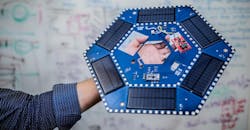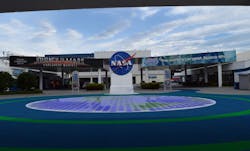Pedestrian-Powered Piezoelectric Tiles Light Up NASA Plaza
Researchers at the Georgia Institute of Technology are designing tiles for a 40,000 ft2 plaza at NASA’s Kennedy Space Center’s Visitor Complex at Cape Canaveral that will light up when people walk on it. The tiles will be piezoelectric, meaning that the visitors walking on the tiles will generate the electricity needed to light them up.
The researchers are using thin, ceramic disks of lead zirconate titanate, which has the strongest piezoelectric response of any known material (meaning it generates more electricity per pound of pressure than any other piezo-material). They will also make use of solar panels. The lights will, therefore, be supplied by renewable energy, one of the goals for the project.
The tiles will be made of thin, ultra-high-performance concrete and contain a small cavity. The cavity will hold circuit boards, six mini solar panels, a lithium battery, 125 LEDs, a Bluetooth transmitter, a Wi-Fi transmitter, microcontrollers, and the piezoelectric disk—all of which are covered by a loadbearing glass tile top.
The tiles operate via two power sources: piezoelectricity and solar panels. The battery will store solar energy for powering the tile at night. The self-powered system, when triggered by a human footstep, generates a wireless signal that informs visitors about NASA space missions, piezoelectric technology, and the cooperation between NASA and Georgia Tech.
An artist’s rendering shows the 40,000 ft2 plaza that will demonstrate applications of piezoelectricity and solar power at NASA’s visitor complex at Cape Canaveral. (Credit: Francisco Valdes, Georgia Tech)
In the entire plaza, about 1,000 tiles light up in various colors. Each glass tile is a pixel in the plaza’s mosaic imagery of Earth, Mars, the moon, and the International Space Station. The piezoelectric elements also power Wi-Fi or Bluetooth signals to visitors’ smartphones, which can play audio, providing information about their geolocation and for potential wayfinding. The audio provides information such as how much energy is being generated throughout the park during the day.
Although a small amount of energy is produced per piezo element, in heavily trafficked areas it would be enough to be stored for local onsite powering of street signs, lights, and other facilities. The piezo elements have long lifetimes, but these are modular systems that could be easily updated over time. The tiles’ glass lids can be removed so the piezo element and electronics can be updated.
The piezoelectric disks will use a method of vibrating a piezo element’s edge, called plucking, that allows coupling the material’s inherently high resonant frequency to the low frequency of human motion. This technique also has various applications intended for harvesting biomechanical energy.
For smart cities, lattices of pressure-sensitive sensors underneath roadways could produce wireless, real-time signals distributing information about roadway conditions, temperature, or traffic. Roadway sensors and autonomous vehicles could share information, and vehicles could communicate with each other through the roadway’s wireless network. Indoor flooring powered by piezoelectricity could provide safety monitoring and sensing capabilities without being plugged into to the grid.


